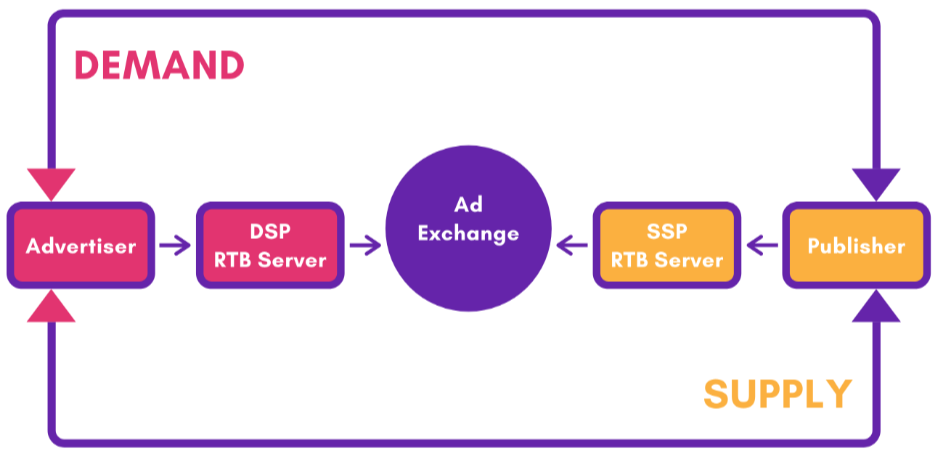You’ve asked, and we’ve answered! We get a lot of questions around programmatic advertising and Google Display Network (GDN). So we’ve put together the most common questions in this post to help you decide what AdTech solutions are best for your business.
What is programmatic advertising?
Programmatic advertising is the automated process of purchasing digital media.
With programmatic ad buying, you use software called demand-side-platform (DSP) to purchase digital advertising. This method replaces the traditional and outdated process that involves RFPs, human negotiations, and manual insertion orders.
Programmatic media buying utilizes data insights and algorithms to serve ads to the right user at the right time, and at the right price.
What is Google Display Network (GDN)?
Google defines Google Display Network (GDN) as a group of more than 2 million websites, videos, and apps where your ads can appear.
While you may not be 100% sure what the Google Display Network (GDN) is, you probably come across it every single day. It’s a system that allows brands to reach their audience while they’re surfing the web — checking their email, watching YouTube, browsing websites, or using mobile apps.
Where do programmatic ads appear?
While GDN has access to all the websites on Google's network, programmatic takes it a step further. Depending on the DSP you use, you can get access to inventory almost anywhere there is ad space available, including on Google's network. Some DSPs are now offering more channels for your advertising:
-
Audio- podcasts, Spotify, Pandora, Internet Radio
-
Billboards- ClearChannel has been working on a nationwide network of Programmatic billboards to be bought in real time
-
Direct Mail- Some companies allow advertisers to retarget customers via post mail based on their online activities
-
TV- Some networks are automating and providing access to their ad inventory via DSPs.
What is a demand-side-platform (DSP)?
A demand-side-platform (DSP) is a third-party software platform that allows advertisers to bid on or buy ad inventory (mobile, search, video ads, and sometimes more) from multiple sources at the same time.
DSPs allow advertisers to buy directly from publishers across multiple ad exchanges via multiple ad exchanges — including Google’s GDN network, which is listed as AdX with relevant DSPs.
Programmatic ad buying is not a free or open platform. To access programmatic ad buying, you must have the infrastructure of a DSP, some of which can cost you upwards of $1 Million before any media spend is added. You will also want to have a knowledgeable programmatic media buyer who understands your DSP of choice to run your campaigns. You can always use an experienced programmatic ad buying agency, like us at Robineau Media, that already has the programmatic infrastructure and programmatic experts to execute your campaigns.
What is a supply-side-platform (SSP)
A supply-side-platform or sell-side platform (SSP) is a technology platform that allows web publishers, app owners and digital out-of-home media owners to manage their advertising inventory, to fill their display, video and mobile real estate with ads, and receive revenue.
SSPs help publishers (and some app developers) monetize their advertising inventory. SSPs enable publishers to make their advertising inventory available to ad exchanges and allow publishers to maximize revenue yield on their impressions across all demand sources. This includes setting minimum pricing levels, rules for allowed advertisers and accepted categories, ad types, and more.
What is an Ad Exchange?
An ad exchange is a virtual marketplace where supply and demand come together to trade advertising inventories via real-time auctions. Ad exchanges allow SSPs and DSPs to connect with each other to buy and sell inventory to the highest bidder based on available information. It is a neutral, autonomous platform that enables the entire buying and selling process via real-time auctions, also called real-time-bidding (RTB).
This simplified illustration shows the process of ad exchanges.

Is Google Display Network programmatic?
The simple answer is no.
Similar to programmatic advertising, GDN uses an auction-based bidding platform to display ads to a target audience across website and mobile applications. Because of these overlapping uses, it’s a common misconception that GDN and programmatic are interchangeable. While they both work toward the shared goal of getting your message in front of a targeted audience, GDN is just one ad exchange as compared to programmatic advertising which is comprised of 20+ ad exchanges (often including GDN).
When choosing a platform for your digital ads, it helps to be aware of the key differences between each option and how they can help or harm your campaigns.
How are GDN and programmatic different?
The GDN is Google's own display network, meaning it's a small subset of the total possible spaces in inventory for programmatic ads online—and it's generally more affordable. With GDN, you're talking about running ads through Google's subsection of the internet. They're a powerful online company, but Google does not have access to every single ad space on the internet.
Programmatic advertising on the other hand offers technology that marketers use to run display ads or native ads across the majority of the internet. Programmatic ad buying offers increased distribution and scale for ads at a higher budget.
GDN and programmatic also differ in audience targeting abilities. GDN uses Google's data (like search, content, and demographics) to target users. Programmatic uses multiple sources of data, including in-depth data from trusted third-party agents and your brand's own first-party data.
How do I know which is best for my business?
GDN may be the best option for you if:
-
You mainly work within a Google Ads environment for display ads and don’t plan on branching out.
-
You aren’t trying to target a very specific or niche audience that may interact with online properties that aren’t part of the GDN network.
-
You want to advertise with display ads on YouTube.
-
Your display ad budget is less than $5,000 a month
Programmatic may be the best option for you if:
-
You have a niche audience that requires advanced targeting tactics. With programmatic you have the ability to use first, second and third-party data to reach your audience.
-
You have a wide scope of products and need personalization to cut through the noise. Programmatic provides multiple opportunities for advertisers to provide a specific message to users at the right time based on audience behavior signals. Specific campaigns can speak to the different audience groups.
-
You have a large advertising budget. When there’s a lot of marketing money at stake, it’s important to have a partner that’s only incentivized to act in the advertiser’s best interest.
Making the Right Choice
Programmatic gives you access to the most robust ad inventory and the most advanced targeting and is a truly valuable option. But before starting with programmatic, you need to make sure that it makes sense for your business and budget. If your budget is limited, Google’s Display Network is an excellent alternative with a lower cost of entry.
Regardless of what platforms you choose, your campaign success relies on having a clear message, great imagery or video content and a strong strategy behind your advertising efforts. If you need help deciding the best platform and tactics for your brand, schedule a call with us. We’ll help guide you through the digital landscape to choose the best option for your business.


